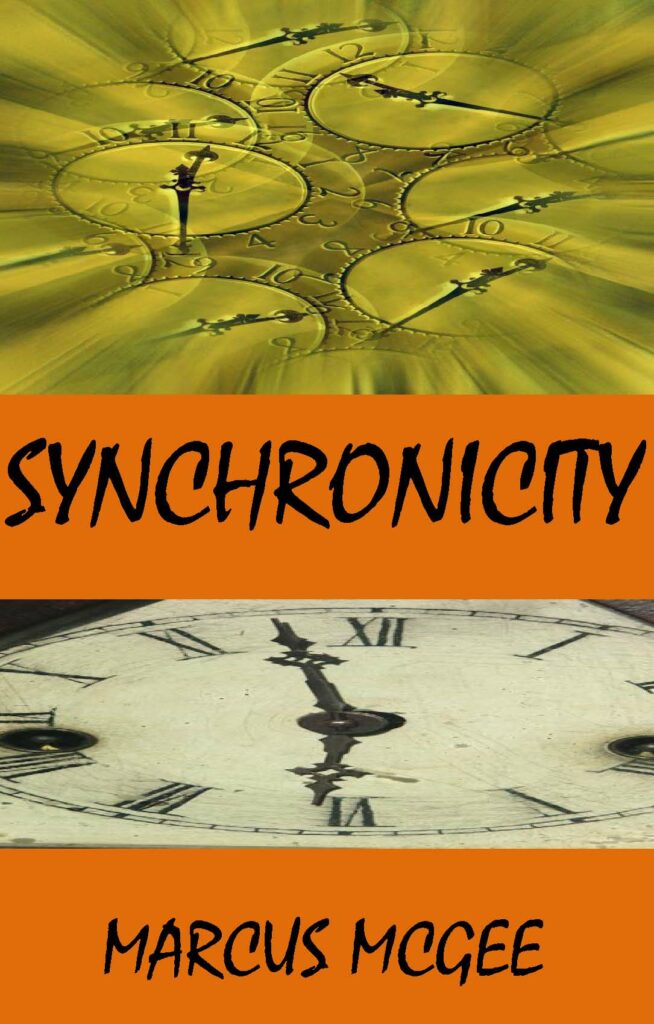
Synchronicity is a second short story collection by Marcus McGee, following Four Stories. This book contains some of the author’s favorite works, including The Club, Estéban and Synchronicity. It also includes his earliest short stories, Mister Peacock, Till Death Do Us Part and Anthropophagi. It finishes with three blank verse parables, Coat of Black, The Man Who Dared to Think and The Crab Who Ruled.
The Club examines the idea of success and the sacrifice involved, Estéban is the story of a talking pig and the plight of the producer in the world, and Synchronicity is a story about the inter-connectivity of life and the universe itself.
Get Your Copy of Synchronicity Today!
Time Out (from Synchronicity)
My greatest ambition is to become an artist. A writer, yes, but an artist at writing first—an artist in a world where the idea of art has died a painful death of triviality. I mourn the loss and cringe as I realize I live in a world where everyone claims to be a so-called “artist.” At risk of sounding elitist, I’ve never been able to accept those claims.
I grew up believing that art was “skill acquired by experience, study or observation,” that art involved some manner of mastery in a particular discipline. Thus I studied the forms, ancient and modern; I struggled through the exercise of practice and emulation; I sacrificed time, loves and years of life because I sought the unique immortality that only an artist might attain. I earnestly studied poetry, history, religion, music, language, psychology, philosophy and politics with the hope that I could bring them all together in a form that could be esteemed as art.
It was one of my primary objectives in the synthesis of Synchronicity, and yet once again I believe I have fallen short of creating real art. I am thankful, however, I have the balance of the life God grants me to grow and learn, and I will continue to seek what humans have sought since the beginning of our existence: immortality.
Synchronicity contains nine stories, which can be divided as follows: The Early Stories—Mister Peacock, Till Death Do Us Part and Anthropophagi; The Main Text—Synchronicity, Estéban and The Club; and The Fables—The Man Who Wore a Splendid Coat of Black, The Tragedie of Those Who Dare to Think and The Crab Who Ruled a Tiny Patch of Mud.
I wrote The Early Stories at a time when I had left poetic plots and had just begun to write stories in prose. Although I had written several plays in college, I was apprehensive about dialogue in text, and this is reflected in Mister Peacock and Till Death Do Us Part, where there is no dialogue. Anthropophagi contains dialogue and a message of love, which may not be readily apparent unless one considers all the possibilities “JC” might represent.
By the time I wrote Synchronicity, I had written two more plays, so I was much more comfortable with allowing my characters to assist at storytelling. Of the many quirkish personalities presented in this book, Ethel in Synchronicity and Tyler in The Club are my favorites.
I love wine and the romance associated with it, from production to consumption. Because I live in Northern California, I have frequently traveled to the Napa Valley in search of new knowledge. On one trip there, I met a memorable group of vineyard workers. On several occasions after, I found them and visited with them for hours. I listened to them; they provided me with a brief glimpse of the lives they lived. Since that time, whenever I raise a glass of California wine heavenward, I think of those workers, who were my friends. I wrote Estéban as a tribute to a family—a man and son—I met during that time. I don’t know what became of them, but I hope someday Carlito will read the story.
Of all the stories in the book, The Club was the most personal to me. It was written during a painful time in my life and reflects the struggle associated with making choices and the inescapable consequences that follow. In the end, it offers the hope that we can get to the truly important things in life.
I wrote The Fables, or The Love Tragedies for my children at a time before I had any children. I wanted the tragedies to be stories that would evolve as my children evolved, providing separate instruction all along the way, according to their ages and maturity levels. To infuse the stories with art, I wrote them in iambic meter—this basically means that every other syllable is accented, producing a natural rhythm in the language of the work. Thus the stories can be appreciated best if they are read aloud.
Thank you for reading this book. I hope you have enjoyed my attempt at art, and I hope you will continue to read my work as I evolve into an artist.
My next work, a full-length novel called The Last Year, is less artful, though upon close inspection, the art will definitely be there.
Until next time—I’ll see you between the sheets!
Marcus McGee

